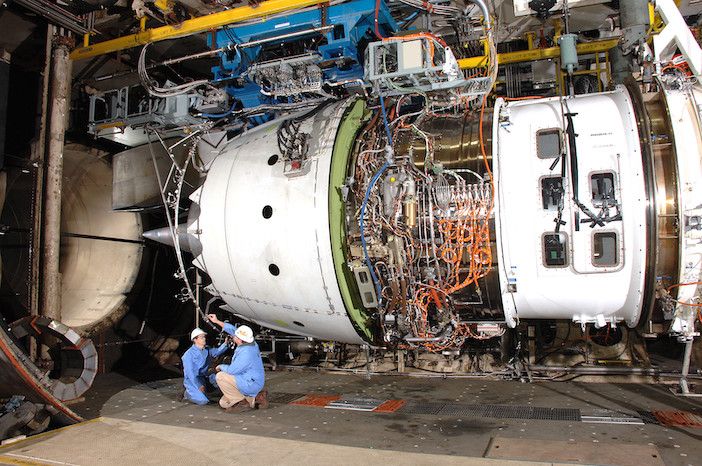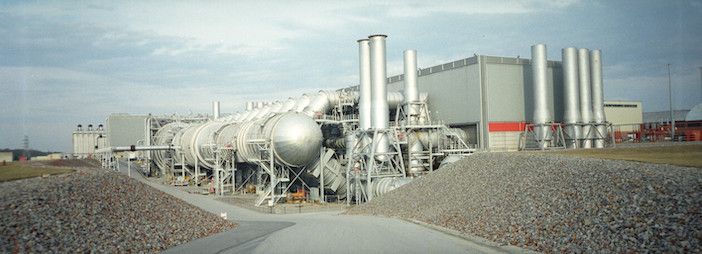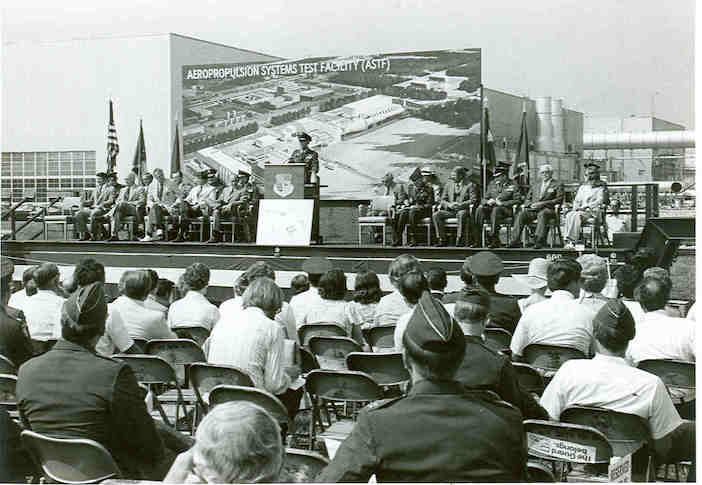The Aeropropulsion Systems Test Facility at Arnold Air Force Base was completed just over 35 years ago this month.
The Aeropropulsion Systems Test Facility (ASTF) was dedicated on October 2, 1984. after taking decades to develop and build.
Speaking this month, Melissa Tate, deputy director of the Aeropropulsion Combined Test Force at Arnold AFB said, “I would like to extend our appreciation for the amazing work done by the Aeropropulsion men and women over the last 35-plus years.
“The endless hours that they have spent working and the professionalism they have shown is impressive. The team members’ diligence, self-motivation, as well as dedication, have been a source of inspiration for us all. I would like to take this opportunity to thank all of you for everything you have done to make this a successful, terrific place to work.”
ASTF, which is part of the Engine Test Facility and is comprised of altitude test cells C-1 and C-2, is designed to test large military and commercial engines in true mission environments. It enables data which was previously only available after extensive flight testing to be acquired through ground testing.
Each test cell within ASTF is more than 25ft in diameter and just under 50ft long. The facility is capable of simulating flight conditions at altitudes up to 75,000ft and at speeds up to Mach 2.3. Either cell can provide engine inlet temperatures of up to 350 degrees Fahrenheit and accommodate engines producing up to 100,000 lbs of thrust.
Large turbofan testing
The C-1 test cell is typically used to conduct performance testing of large augmented turbine engines that power supersonic military fighters and bombers. While C-2 can also be used for testing these engines, the test cell has more recently been used for performance testing of large turbofan engines that power large commercial airliners.

Aeromechanical testing, vectored-thrust testing, icing testing and inlet pressure distortion testing may also be accomplished in ASTF.
It took around two decades of planning and more than a half-billion dollars to bring ASTF to Arnold AFB. In the 1960s, NASA and the Department of Defense Aeronautics and Astronautics Coordinating Board identified ASTF as essential to the nation, as a facility designed for testing integrated, full-scale propulsion systems under more realistic simulated flight conditions was needed.
Construction on ASTF began in 1977, took seven years to complete and cost US$625 million to build. The conception of the facility involved numerous government agencies and aerospace companies, and the construction involved around 700 different companies.
The integration and activation of ASTF followed its dedication. The facility reached initial operational capability in September 1985, a little under a year after the dedication ceremony.
In recent years, ASTF has been used to test F119 engines for the F-22A Raptor aircraft and F135 engines for the F-35 Lightning II aircraft. Turbofan engines such as the Rolls-Royce Trent 800 for the Boeing 777, the Trent 900 and GP7200 for the Airbus A380, the Pratt & Whitney 6000 for the Airbus A318, the Trent 1000 for the Boeing 787, the XF7-10 for the Kawasaki P-1, and the BR725 for the Gulfstream G650 have been tested in ASTF.
“We are the beneficiaries of our predecessors’ foresight, technical skill and dedication,” said Lt. Col. Lane Haubelt, director of the Aeropropulsion CTF at Arnold AFB. “ASTF remains an extremely capable test facility and is the centerpiece of advanced turbine altitude testing for the nation. The task in front of us now is sustaining this world-class test capability while investing to keep ASTF the facility of choice for propulsion system test and evaluation over the next 35-plus years.”

ASTF Build Highlights and Milestones:
- November 1972 – A contract was awarded to the architectural-engineering joint venture firm of Daniel, Mann, Johnson and Mendenhall /Norman Engineering Co. for the design of the Aeropropulsion Systems Test Facility.
- April 1976 – The resource plan for construction of ASTF was completed.
- September 1976 – President Gerald R. Ford signed into law the military construction bill that included US$437 million for construction of ASTF.
- March 1977 – The first design packages for ASTF were delivered to the Corps of Engineers, Mobile District, by DMJM/Norman.
- May 13, 1977 – Groundbreaking ceremonies were held at the construction site marking the official beginning of the construction project.
- August 4, 1977 – Bids were opened for the construction package.
- Aug. 10, 1977 – The ASTF construction contract was awarded to a joint venture of Morrison-Knudsen Co, American Bridge Division of US Steel, and Fischback and Moore.
- September 1977 – Site preparation for ASTF construction began.
- Spring 1978 – Construction began.
- March 1980 – A ringer crane, with a lifting capacity of 1.2 million lbs, lifted one of the largest single components of the test facility, a cooling equipment section weighing 920,000 lbs, into place.
- May 1980 – The first of the two ASTF test cells was put into place.
- October 1980 – The world’s largest butterfly valve was installed. The valve, listed in the Guinness Book of World Records, is 32ft in diameter and weighs 170 tons.
- November 1982 – Two electrical transformers were energized, marking the first major step to powering the facility.
- November 1982 – The final piece of ducting was hoisted into place.
- March 1984 – Installation and check of the Variable Frequency Starting System was completed approximately five months ahead of schedule by Sverdrup personnel.
- April 1984 – One of ASTF’s 52,500-horsepower air supply compressors was started and accelerated to 3,600 revolutions per minute, a major step to achieving air-on capability.
- September 1984 – AEDC received an operational F100 engine on loan from the Aeronautical Systems Division, Wright-Patterson AFB, Ohio. The engine was to be used to verify that ASTF can safely conduct testing.
- September 1984 – The first phase of the Test Instrumentation System (TIS), the prime engine parameter system, was delivered to AEDC by Grumman Data Systems. The TIS acquires, conditions, processes, records and displays engine data from the facility’s test cells.
- October 2, 1984 – ASTF was dedicated.
- January 1985 – The first full-scale activation test was successfully conducted with an engine simulator in test cell C- 1.
- April 1985 – An F100 turbofan engine was successfully run in C-1 for more than an hour at a simulated flight condition of 16,000ft altitude and 0.8 Mach number.
- June 1985 – The Automatic Test Control System (ATCS), that automatically controls the setting of engine altitude test conditions in ASTF, was delivered by Science Applications International Corporation.
- July 1985 – The first F100 engine test using 50 of the 500 TIS data channels was successfully conducted.
- September 1985 – The first test of the ATCS providing air supply leg stabilization was conducted with an engine simulator in test cell C-2.
- September 26, 1985 – An F100 test using the TIS and the ATCS was successfully conducted signaling ASTF for Initial Operational Capability.
This article was originally published by the US Air Force here.





